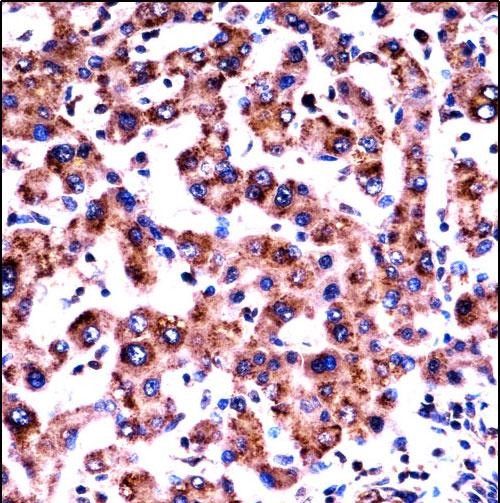HRH1 Antibody (Center)
Affinity Purified Rabbit Polyclonal Antibody (Pab)
- SPECIFICATION
- CITATIONS: 1
- PROTOCOLS
- BACKGROUND

Application
| IHC-P, WB, E |
|---|---|
| Primary Accession | P35367 |
| Other Accession | NP_000852.1, NP_001091682.1 |
| Reactivity | Human |
| Host | Rabbit |
| Clonality | Polyclonal |
| Isotype | Rabbit IgG |
| Calculated MW | 55784 Da |
| Antigen Region | 273-301 aa |
| Gene ID | 3269 |
|---|---|
| Other Names | Histamine H1 receptor, H1R, HH1R, HRH1 |
| Target/Specificity | This HRH1 antibody is generated from rabbits immunized with a KLH conjugated synthetic peptide between 273-301 amino acids from the Central region of human HRH1. |
| Dilution | IHC-P~~1:10~50 WB~~1:1000 E~~Use at an assay dependent concentration. |
| Format | Purified polyclonal antibody supplied in PBS with 0.09% (W/V) sodium azide. This antibody is purified through a protein A column, followed by peptide affinity purification. |
| Storage | Maintain refrigerated at 2-8°C for up to 2 weeks. For long term storage store at -20°C in small aliquots to prevent freeze-thaw cycles. |
| Precautions | HRH1 Antibody (Center) is for research use only and not for use in diagnostic or therapeutic procedures. |
| Name | HRH1 (HGNC:5182) |
|---|---|
| Function | G-protein-coupled receptor for histamine, a biogenic amine that functions as an immune modulator and a neurotransmitter (PubMed:33828102, PubMed:8280179). Through the H1 receptor, histamine mediates the contraction of smooth muscles and increases capillary permeability due to contraction of terminal venules. Also mediates neurotransmission in the central nervous system and thereby regulates circadian rhythms, emotional and locomotor activities as well as cognitive functions (By similarity). |
| Cellular Location | Cell membrane; Multi-pass membrane protein |

Provided below are standard protocols that you may find useful for product applications.
Background
Histamine is a ubiquitous messenger molecule released from mast cells, enterochromaffin-like cells, and neurons. Its various actions are mediated by histamine receptors H1, H2, H3 and H4. This gene was thought to be intronless until recently. The protein encoded by this gene is an integral membrane protein and belongs to the G protein-coupled receptor superfamily. It mediates the contraction of smooth muscles, the increase in capillary permeability due to contraction of terminal venules, the release of catecholamine from adrenal medulla, and neurotransmission in the central nervous system. Multiple alternatively spliced variants, encoding the same protein, have been identified. [provided by RefSeq].
References
Bailey, S.D., et al. Diabetes Care 33(10):2250-2253(2010)
Ruano, G., et al. Pharmacogenomics 11(7):959-971(2010)
Davila, S., et al. Genes Immun. 11(3):232-238(2010)
Notcovich, C., et al. Exp. Cell Res. 316(3):401-411(2010)
Talmud, P.J., et al. Am. J. Hum. Genet. 85(5):628-642(2009)
If you have used an Abcepta product and would like to share how it has performed, please click on the "Submit Review" button and provide the requested information. Our staff will examine and post your review and contact you if needed.
If you have any additional inquiries please email technical services at tech@abcepta.com.














 Foundational characteristics of cancer include proliferation, angiogenesis, migration, evasion of apoptosis, and cellular immortality. Find key markers for these cellular processes and antibodies to detect them.
Foundational characteristics of cancer include proliferation, angiogenesis, migration, evasion of apoptosis, and cellular immortality. Find key markers for these cellular processes and antibodies to detect them. The SUMOplot™ Analysis Program predicts and scores sumoylation sites in your protein. SUMOylation is a post-translational modification involved in various cellular processes, such as nuclear-cytosolic transport, transcriptional regulation, apoptosis, protein stability, response to stress, and progression through the cell cycle.
The SUMOplot™ Analysis Program predicts and scores sumoylation sites in your protein. SUMOylation is a post-translational modification involved in various cellular processes, such as nuclear-cytosolic transport, transcriptional regulation, apoptosis, protein stability, response to stress, and progression through the cell cycle. The Autophagy Receptor Motif Plotter predicts and scores autophagy receptor binding sites in your protein. Identifying proteins connected to this pathway is critical to understanding the role of autophagy in physiological as well as pathological processes such as development, differentiation, neurodegenerative diseases, stress, infection, and cancer.
The Autophagy Receptor Motif Plotter predicts and scores autophagy receptor binding sites in your protein. Identifying proteins connected to this pathway is critical to understanding the role of autophagy in physiological as well as pathological processes such as development, differentiation, neurodegenerative diseases, stress, infection, and cancer.


